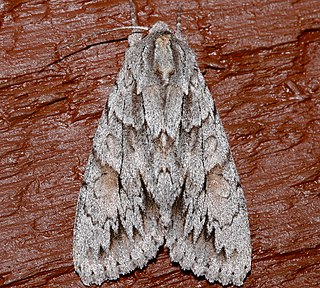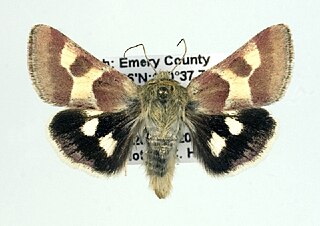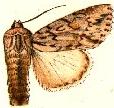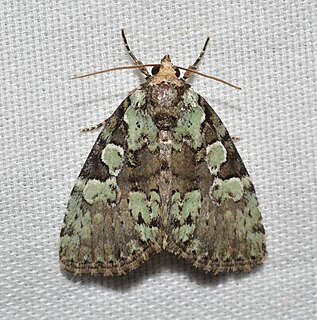
Acronicta lanceolaria, the lanceolate dagger moth or pointed dagger, is a moth of the family Noctuidae. The species was first described by Augustus Radcliffe Grote in 1875. It is found in North America, from Nova Scotia to British Columbia. It is listed as a species of special concern and believed extirpated in the US state of Connecticut.
Afotella is a monotypic moth genus of the family Noctuidae erected by William Barnes and Foster Hendrickson Benjamin in 1926. Its only species, Afotella cylindrica, was first described by Augustus Radcliffe Grote in 1880. It is found in western North America from Saskatchewan and Alberta south to California.

Chytolita is a monotypic litter moth genus of the family Erebidae erected by Augustus Radcliffe Grote in 1873. Its only species, Chytolita morbidalis, the morbid owlet moth or morbid owlet, was first described by Achille Guenée in 1854. It is found in large parts of North America, from coast to coast in the north and south to North Carolina, Texas and Florida in the west. The habitat consists of deciduous woods and edges.

Catocala meskei, or Meske's underwing, is a moth of the family Erebidae. The species was first described by Augustus Radcliffe Grote in 1873. It is found in North America from Maine and Quebec west to southern Alberta and Montana, south to South Carolina in the east and at least Montana in the west.

Acronicta dactylina, the fingered dagger moth or alder dagger, is a moth of the family Noctuidae. The species was first described by Augustus Radcliffe Grote in 1874. It is found from Newfoundland west to the Pacific coast and Vancouver Island and Haida Gwaii, British Columbia, south to North Carolina and Colorado.
Acronicta vulpina, the vulpina dagger moth or miller dagger moth, is a moth of the family Noctuidae. The species was first described by Augustus Radcliffe Grote in 1883. It is found in North America from New York and Newfoundland west to central British Columbia, south to Colorado.

Andropolia theodori is a moth in the family Noctuidae first described by Augustus Radcliffe Grote in 1878. It is found in the eastern parts of North America, from British Columbia, south to California.

Apamea plutonia, the dusky Quaker or dusky apamea, is a moth of the family Noctuidae. The species was first described by Augustus Radcliffe Grote in 1883. It is native to northern North America, where it occurs across the boreal regions, with some occurrences from as far south as New Mexico and Pennsylvania.
Capsula oblonga, the oblong sedge borer, is a moth of the family Noctuidae. The species was first described by Augustus Radcliffe Grote in 1882. It is found across southern Canada from the Maritimes to British Columbia, south to the Gulf of Mexico and southern California.
Capsula subflava, the subflava sedge borer or yellow sedge borer, is a moth of the family Noctuidae. The species was first described by Augustus Radcliffe Grote in 1882. It is found in North America from Nova Scotia west to British Columbia, south to New Jersey in the east and Utah and California in the west.

Schinia suetus is a moth of the family Noctuidae first described by Augustus Radcliffe Grote in 1873. It is widespread in the mountains of western North America, from southern Alberta west to British Columbia, south at least to Colorado and California, east to Idaho and New Mexico.

Acronicta lupini, the lupine dagger or little bear, is a moth of the family Noctuidae. The species was first described by Augustus Radcliffe Grote in 1873. It is found from Quebec, Newfoundland and Labrador, British Columbia, Alberta and Yukon in Canada, south to California.
Copablepharon longipenne, the dusky dune moth, is a moth of the family Noctuidae. The species was first described by Augustus Radcliffe Grote in 1882. It is found in North America from south-western Manitoba to southern Alberta, south to western Texas.

Andropolia diversilineata is a moth in the family Noctuidae first described by Augustus Radcliffe Grote in 1877. It is found in western North America, from British Columbia south to California.

Andropolia olorina is a moth in the family Noctuidae first described by Augustus Radcliffe Grote in 1876. It is found in California and Nevada.
Euxoa campestris, the flat dart, is a moth of the family Noctuidae. The species was first described by Augustus Radcliffe Grote in 1875. It is found in North America from Newfoundland to Alaska, south to New England and southern Canada from southern Quebec west to British Columbia. In the west it is distributed southward in the Rocky Mountains to southern New Mexico, east-central Arizona, and central Utah. In the east it occurs in the Appalachians in eastern Kentucky and in western North Carolina.
Xestia normaniana, or Norman's dart, is a moth of the family Noctuidae. The species was first described by Augustus Radcliffe Grote in 1874. It is found in North America from Nova Scotia across southern and central Canada to Alberta. In the eastern United States it ranges from Maine to eastern Minnesota, and south along the Appalachians to western North Carolina. It has recently been recorded from Tennessee.
Chrysanympha formosa, the Formosa looper, is a moth of the family Noctuidae. The species was first described by Augustus Radcliffe Grote in 1865. It is found in North America from Newfoundland west to Manitoba and south to the mountains of North Carolina and Tennessee.

Euxoa citricolor is a moth of the family Noctuidae first described by Augustus Radcliffe Grote in 1880. It is found in North America from eastern South Dakota and western North Dakota, northwest to southern Alberta, west to western Washington and south and east to southern California, New Mexico and Colorado.

Leuconycta lepidula, the marbled-green leuconycta moth, marbled-green jaspidia or dark leuconycta, is a moth of the family Noctuidae. The species was first described by Augustus Radcliffe Grote in 1874. It is found in North America from Nova Scotia to North Carolina, west to Texas and north to Alberta.




